A few weeks ago I came to the conclusion that certain beef cuts, specifically the ones that don’t have much marbling from fat, were just as tender and tasty from grass-fed cows as they were from cows that were finished in a feedlot on corn or other grains. In a little home experiment, skirt and flank steaks from grain-fed and grass-fed cows scored equally. And when you brought price into the equation, grass-fed was the clear winner (if you want, you can read about it here: https://dondayinsma.com/2016/10/31/chasing-skirts-following-flanks-continuing-saga-steak-obsessed-man-san-miguel/).
But what about those fancy cuts of beef? How would premium-priced steaks perform in a competition.
I decided that I’d eaten enough rib eyes and strip loins to know how they’d measure up. Those cuts are like Sumo wrestlers. They depend on fat and, up to a certain point, that point where they have names like Wagyu and Kobe and require taking out a second mortgage, the more fat the better.
But what about that other premium cut? The one that some people choose for the very reason that it has little fat. What about the tenderloin? What about the filet?
It was time to put on the white smock coat and get out the test tubes again. OK, so maybe just an apron and a couple of red wine glasses.
And, if there was going to be very good beef and reasonably good wine, why not invite some other committed carnivores. Make it a dinner party. The initial plan was to do it on our roof terrace, where our barbecue makes its home. But sometimes it gets chilly on the roof. And besides, doing it at home might mean I’d be on dish duty.
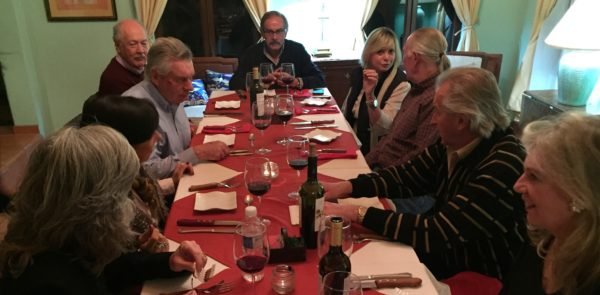
So we decided to do it out. And what better place than a steakhouse. And what better steakhouse than Winston’s.
Winston’s opened its doors about six months ago. It’s about 50% restaurant. It’s about 50% butcher shop. It’s 100% dedicated to deep red Certified Angus aged strip loins, and rib eyes with bone in or out, marbled with creamy fat.
“Why?”, I asked, chef and owner of Winston’s, Tim Inscore.

“It’s simply because they’re the very best cuts of beef you can possibly eat,” Tim replied. “Which is the overall concept of Winston’s…the best…from the appetizers to the desserts and, of course, the beef.”
If you’ve been in San Miguel de Allende for as long as Don Day, you might remember Tim Inscore. Tim owned Cafe Iberico in Colonia San Antonio, the Spanish tapas bar that was as regular a haunt as I’ve ever had in this town. Success unfortunately spoiled Cafe Iberico. It moved to Centro, to fancy digs on Mesones. And it just wasn’t the same. It lost its intimacy, its buzz. Tim was out front as often as he was in the kitchen. The place became more like Restaurant Iberico than Cafe Iberico and I stopped hanging there.
It wasn’t too much longer that Tim Inscore was gone as well. He moved to Queretaro and opened La Pata Negra, a restaurant dedicated to Spain’s black-hooved pigs, but found this time it wasn’t the restaurant that was too big, it was the town.
“Queretaro is like a mini Mexico City now. It’s not for me,” Tim said.

So Tim is back in San Miguel and is smiling again. He hasn’t aged much in the ten or so years I’ve known him. Still has a bit of a Carolina accent. Still very low-key, mild-mannered. Maybe the hairline has moved to the rear a touch. Maybe he’s put on the weight of three or four of those big bone-in rib eyes that Winston’s specializes in. But that’s all.
And Winston’s? It’s small. It’s warm. It’s comfortable. It’s cozy. And with a maximum capacity of 16, it’s just about the size of the original Cafe Iberico. And just about right for our gathering of judges and jury.
Now I had to ask a special favor of Tim. Because Winston’s doesn’t usually stock and sell filets. But could he, for one night only as the concert posters say, source some grain-fed and grass-fed filets, about four or five ounces each, and serve them to us plated side by side? I don’t know if it was because Tim remembered and liked our crowd or remembered how much wine we drank and the profit he could make on the evening. Tim said yes.

The emails went out and, one week later, after a few struggles finding the place (it’s up by the botanical gardens), 16 people were armed with weapons of mass consumption and ready for action.
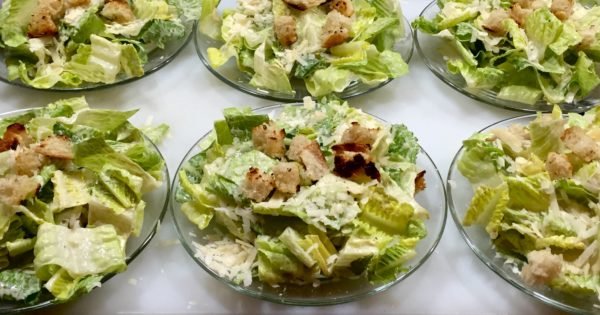
Orders were taken from a small but well-selected and well-priced list of reds and the warm-up to the filets, a very steakhousey Cesar salad with an overabundance of garlic, a sufficient quantity of anchovies, some very crispy romaine and a not too wet/not too dry amount of dressing was served. And no I didn’t spell Cesar wrong. The origin of the dish is in Tijuana at a restaurant called Cesar’s. Just like at those restaurants of old, Tim usually does the dish table-side so he apologized for the conventional service. But he had 32 steaks to cook.
On the left were the grain-fed filets, about as marbled as I’d ever seen the cut. Certified Angus. No hormones or antibiotics. Imported from north of the border and rated even better than the highest USDA standard, Prime, which puts the steaks in the top 2% of all graded meat.

On the right were the grass-fed filets, with just the tiniest little rivulets of fat. From local cows and bought at a butcher shop in Queretaro. Totally unrated.
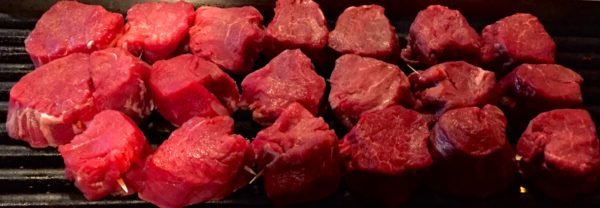
I asked Tim to cook them medium rare to medium. He spiced them with just a little bit of sea salt and pepper. And on to the mesquite wood grill they went.

Massive, possibly smuggled-into-Mexico, contraband Russets came out of the oven and were dressed with sour cream, chives and an abundance of butter. Mini eggplants parmesan were placed on the side. And a stick went into the grain-fed filet so we’d know which steak was which.

The crowd was quiet at first. Taking a bite from one filet, then a bite from the other. Then the chatter started. Nobody seemed to be proclaiming a major victory of one over the other. I had a feeling it was going to be close.

I ordered a second bottle of Rioja, finished my steaks quickly, tried hard to finish my potato and started my walk-around with pencil and paper, recording what each filet scored out of ten.
I started with Jack who thought the grain-fed may have been more tender but said, “I don’t mind a little chew and it was worth it for the taste of the grass-fed.”
Jack’s friend Rosi was perhaps the most diplomatic of the judges and declared it, “a tie”.
New friend and former chef Mark found “both extremely tender” but went for the grain-fed on taste.
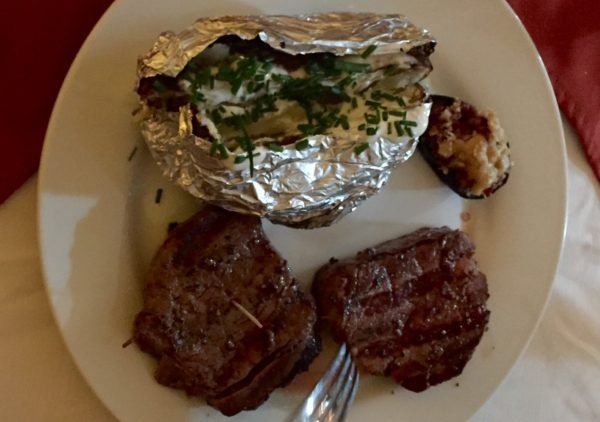
Richard, Don Day’s oldest of all friends, the guy that taught me that chasing women was a more pleasurable sport than chasing baseballs, went for the grass-fed. “I liked the texture. It was more moist”, said Rich.
Rich’s wife Eileen went the opposite way, voting for the grain-fed. Perhaps that’s what it takes to be married for 50 years.
I was quite amazed at this point. When I first organized the event, I thought the grain-fed might whomp the grass-fed but a quick tally showed the grass-fed a whisker ahead as I moved to the second table.

Then, as Tim Inscore began plating the Tarta Santiago, a Spanish almond tart with home-made ice cream, the tides suddenly turned. Paula, Lou, Kathy, Marie-Claude, Cythia and Gary all raised their hands for grain-fed. Things had swayed in the other direction.
Next was Charlie who said, “The corn has more flavor but the texture of the grass gives it my vote.”
“And mine”, said Andy, as I wrote down their rather decisive numbers.
It was down to Don Day’s Wife.
“I thought the grain-fed was a little wishy-washy. It had that previously-frozen, mealy taste and texture. 10 for the grass. 6 for the corn,” said my always-opinionated-when-it-comes-to-food wife.”
I did the tally. Checked it twice. Did the steak knife against the glass trick to compete with the wine-speak for attention.

“The results of the filet cook-off are (yes, I did the delay just like Michael Buffer when he does the fights in Vegas) grass-fed 114, grain-fed 115. The winner and champion of the filet cook-off is…”
“No it isn’t”, came a voice from the crowd, “you missed my vote.”
Apparently there had been a hanging chad or a quieter-than-usual Stan. Despite his six foot plus stature, I had missed Stan.

“I scored 8 for the grain-fed and 10 for the grass-fed”, he said.
(Tinkle sound of knife on glass again) “We’ve had a recount. The winner of the filet cook-off is the grass-fed.”
I was surprised, very surprised. And I knew something about each of the filets that the rest of the judges didn’t. I knew what Tim Inscore had paid for the filets. The grass-fed filets were half the price of the grain-fed.

“And imagine if you’d wrapped those grass-feds in bacon”, said Tim, “you’d think you’d have died and gone to heaven.”
I decided a couple of things that night.
I really like Winston’s because it’s like eating in someone’s home. There’s a dining room with a crackling wood fire, a salon to enjoy an aperitif, a kitchen so open that you can walk in and check things out without apologizing, the ever-gracious host Tim Inscore, and some dry-aged rib eyes in the fridge that were definitely worth coming back for.
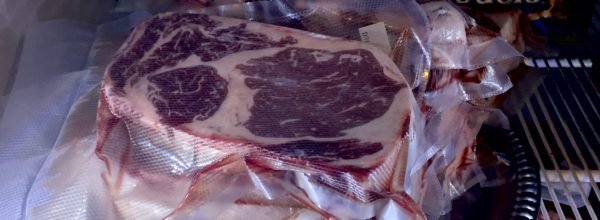
The second decision I made was about grass-fed filets. I’ve always believed that cows fed mostly on grass were happier cows. And I’ve always believed that humans fed on grass fed beef were healthier humans. Now I believed that I would never buy a filet from corn-finished feedlot cows again. I would support my local cattle ranches. I would support my local carnicerías.
I felt really good that night. And it wasn’t just the wine.
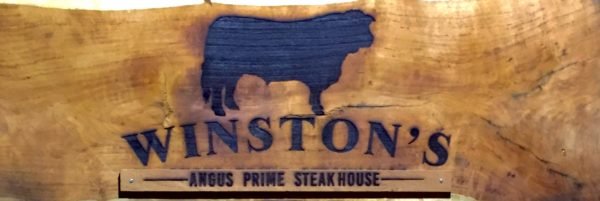
Winston’s Steak House is located at Prolongacion de Cuesta de San Jose, #101 in San Miguel de Allende, Mexico. The restaurant is open for dinner only on Thursdays, Fridays and Saturdays. Reservations are essential and can be made at 415 124 8393 or winstonsteakhouse@gmail.com. Steaks can be grilled conventionally or cooked at your table atop a Himalayan salt tablet. The restaurant’s Facebook page (Winston’s Angus Prime Steakhouse) has descriptions and a lot of photos. Each cut is Certified Angus, 30-day dry aged beef. Steaks can also be purchased for serving at home. Rib eyes are $.75 a gram, New York strip loins are $.65 a gram, rib eyes with the bone in are $.85 a gram. The average size of the rib eyes and strip loins are 500 grams and they’re designed for two people. The bone in rib eyes are approximately 1000 grams and are designed for four. To order and arrange to pick up steaks, use the same phone number and email address.

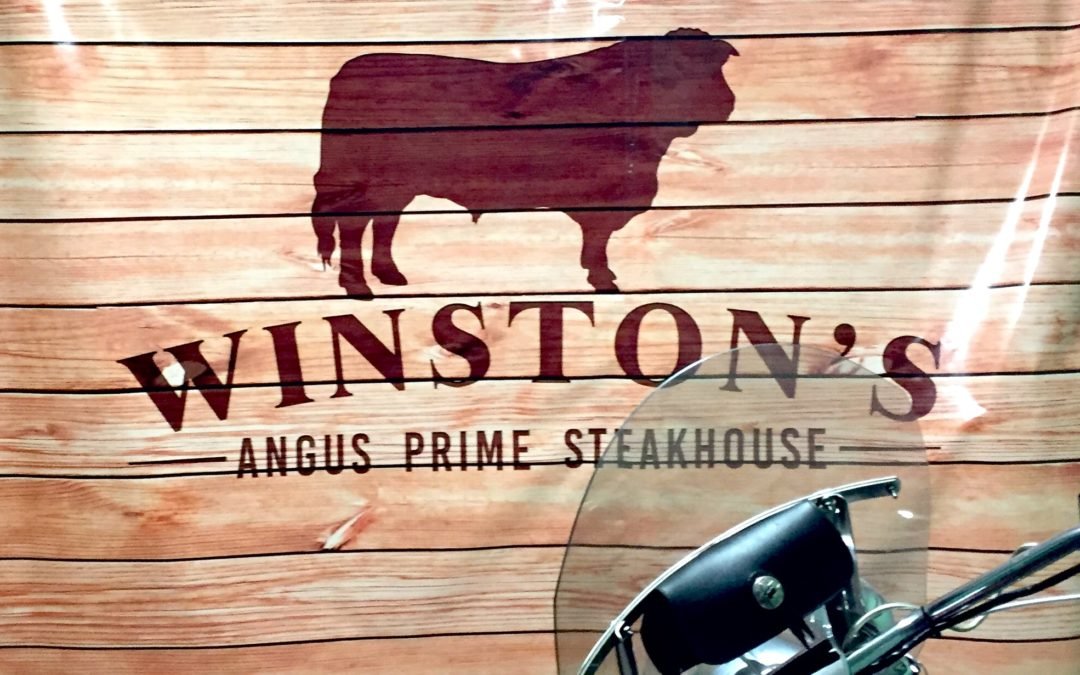
What was the butcher shop in Queretaro where the grass feds were purchased?
I’m not sure Mark. Tim from Winston’s picked them up. I’ll ask him to let you know.
Iwant the name of the butcher shop, too!
Good to hear about Winstons. I walk by it about every day.
Do they serve more than beef?
Just beef, I think.
So, are the “standard fare” rib eyes and strip steaks that Winston’s serves on a regular basis grass fed or grain fed?
All grain-fed.
Great article! And I’d also like to know if the standard steaks at Winston’s are grass fed…which I would prefer, by far! I’m looking forward to checking Winston’s out soon. Thanks!
They’re all grain-fed. But being strip loins and rib eyes, from experience I can almost guarantee their taste will beat grass-fed every time. But maybe for another blog post…
I’m more interested in the health aspect of grass vs grain fed. Would love the address of the place in Queretaro that sells grass fed meats.
I don’t know the Queretaro butchers, Carla, but, by all appearance, every San Miguel butcher that I I buy from sells mostly grass-fed beef, though there may be some cactus forage and some seasonal grain.
But the real missing variable in the equation of grass vs. grain fed beef is the amount of time the meat was hung and aged … no time for meat in Mexico and that means less flavor whether it is grass or grain beef.
Period … end of equation